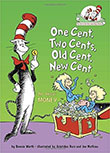One Cent, Two Cents, Old Cent, New Cent: All About Money Q&A

Use these questions with children 7 to 10 years old to discuss the following economic concepts in One Cent, Two Cents, Old Cent, New Cent: All About Money: barter, characteristics of money, interest, and money.
View all of our Parent Q&A resources.
Book written by Bonnie Worth (ISBN: 978-0-375-82881-2).
This book is available on https://www.bookshare.org/cms/ for free to schools and students with reading barriers.
Questions:
1. What word describes the beekeeper swapping his honey with the farmer for wheat?
Barter
2. Barter is trading without using money. Would the beekeeper be able to swap with the farmer if the farmer didn't like honey?
No
3. What are some reasons money was invented? "It was easier to use and decay was prevented." "It was easy to carry and count, and what's more, it was easy to save and easy to store."
4. What are some examples from the book of things that have been used as money?
Shells, feathers, eggs, leather, and jade
5. Why weren't these successful as money?
Eggs break and leather gets dirty. The items weren't solid and sturdy.
6. What else did people use as money?
Copper, silver, and gold ingots [which are like bricks]
7. What was difficult about using these as money?
They weren't easy to haul around.
8. What "brainstorm" did someone in Lydia have?
To make metal coins
9. Why were metal coins useful as money?
They were handier. They were easier to carry [portable], sturdy [long-lasting], durable [we are still digging them up], and the same shape and size [uniform].
10. In ancient time, where did people keep their money?
Temples
11. Why did people keep their money in temples?
It was a safe place to keep their money.
12. What is interest?
Interest is the amount of money a bank pays you for keeping your money in a savings account. It is also the amount a bank charges you [a fee you must pay] when you borrow money.
13. What do you call someone who collects and studies money?
A numismatist
14. What type of money did people make after metal coins?
Paper money
15. What do we "mostly use all these coins" for?
To make change
16. Being able to make change means our money is divisible. What type of money from the islands of Yap wasn't divisible or portable?
Limestone coins eight-feet wide
17.Why is U.S. paper money made from linen and cotton?
So it is more durable [longer-lasting] and doesn't rot.
18. So, what makes something useful as money?
To be useful as money, something must have certain characteristics. It must be
- durable—doesn't rot,
- portable—easy to carry around,
- divisible—we can make change,
- relatively scarce—everyone can't just make their own, and
- generally acceptable—people are willing to use it to save and to spend.
---
If you have difficulty accessing this content due to a disability, please contact us at economiceducation@stls.frb.org or call the St. Louis Fed at 314-444-8444 and ask for Economic Education.

